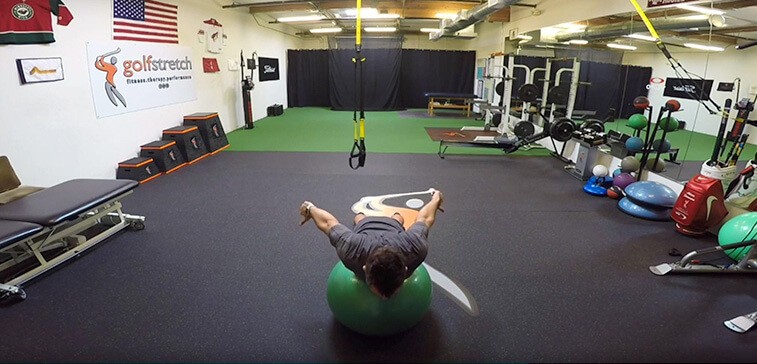
Blog Breakdown:
- Studies show that having more shoulder flexion can help improve a golfer’s swing.
- Even if the end goal isn’t to improve your golf game, having a full range of motion in your shoulders can help prevent injury and increase flexibility for daily living.
- In this blog, CEO of Golfstretch Adam Swanson demonstrates an upper body exercise to improve shoulder flexion and shoulder extension.
For the trainers at the Titleist Performance Institute, golfers who are serious about improving their golf game typically work hard to correct any handicaps that may exist in their swing. In order to rectify these handicaps, a golfer may need to undergo a series of tests to help identify any pre-existing physical ailments.
One test that is performed on amateur and professional golfers often is the Lat Test. This golf screening test helps trainers determine the level of shoulder flexion an athlete has and if there are any handicaps that could result in an injury.
For those unfamiliar with the Lat Test, it is a simple test that can be performed in the comfort of your own home. Although it is simple and easy to do, it can help identify a number of potential shoulder flexion and extension issues. First, you’ll need to stand against a wall before slowly sliding down to a squat position. Your legs should make a 90-degree angle with your feet directly below your knees. Make sure your lower back is flat against the wall.
To begin this test, your arms should be kept straight at your sides with your thumbs pointing forward. When you’re ready, raise both arms over your head, keeping them straight as they go up. If you can touch the wall behind you with your thumbs without bending your elbows or arching your lower back, then you have full range of motion in your shoulders. If you begin to experience pain at any point during the test, stop immediately and either take note of your symptoms or inform your golf trainer.
The lats are one of the largest muscles groups, so pain could greatly impact your golf game and quality of life. That’s where this exercise may come in handy. I see many golfers with poor shoulder flexion and extension, and I understand how these discrepancies can impact their golf swing. To help improve your flexibility and range of motion in the shoulders, consider adding this exercise, which is called “I’s On The Ball,” into your workout routine. For this exercise, you’ll need a 55-65 cm stability ball.
Start by lying flat on the stability ball, situating it on the center of your chest or below the chest on your core, whichever is more comfortable. Keeping your arms straight and your thumbs pointed upward, pull your arms and shoulders backward until they reach maximum flexion. Repeat this move 10-15 times. While you’re in this position, make sure you squeeze your quads, glutes, and core.
After completing this exercise, you can begin the shoulder extension portion by moving your arms forward. Repeat this motion 10-15 times with your quads, glutes, and core fully engaged. Make sure you complete this exercise “as is” before adding weights. If you’re worried this exercise won’t be enough to improve your shoulder’s range of motion, call me today to set-up an appointment at Golfstretch. I will develop a comprehensive golf fitness plan to help you get back on track with little to no pain. Call me today!
Golfstretch is a sports performance and rehabilitation center located in Scottsdale, Arizona. Utilizing a combination of therapies, the team at Golfstretch helps clients achieve their health and fitness goals. To learn more about golf fitness, stretch therapy, corrective exercise, and more, call 480-269-1119 to schedule a consultation today! We look forward to hearing from you!
The advice and information contained in this article is for educational purposes only and is not intended to replace or counter a physician’s advice or judgment. Please always consult your physician before taking any advice learned here or in any other educational medical material.
